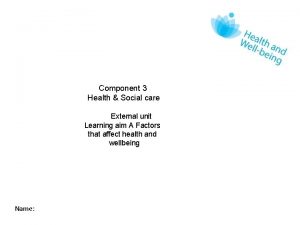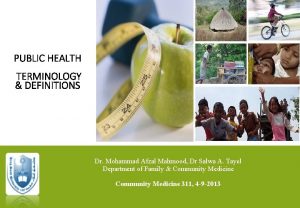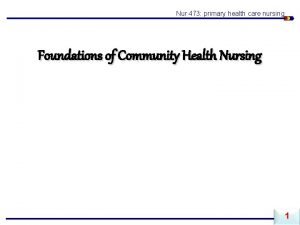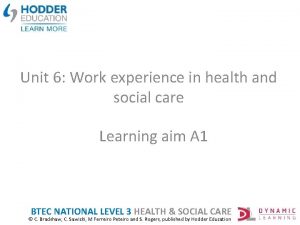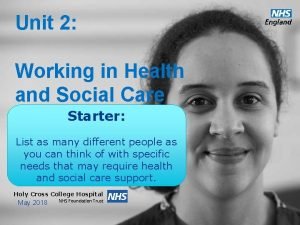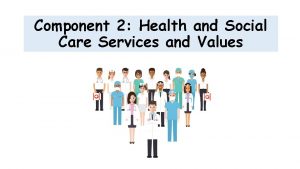Component 2 Health and Social Care Services and












- Slides: 12

Component 2: Health and Social Care Services and Values

Learning Outcome: • To be able to identify a range of services available for children and young people and discuss the types of support offered by a social care worker. Key words: Social care, support, services, emotional, foster care, residential care, youth work.

Social Care Worker “Social workers work with people and families to support them through difficult times and ensure that vulnerable people, including children and adults are safeguarded from harm. Their role is to provide support and help in order to improve outcomes in people's lives. ” In pairs, answer the following questions in your books: 1. 2. What is meant by the word ‘safeguard’? 3. 4. What other healthcare professionals would social care workers work collaboratively with? Give examples of when you may need a social care worker. Can you link this to any instances you have heard in the media/news? What outcome would they aim to achieve?

Social Care Worker Sometimes children and young people need support from a social care worker. Why might some children/young people need a social care worker? Task: Create a mind map around what you feel would make a good social care worker. Extension: Consider what types of support the social care worker would offer the child. What skills/personal attributes would they need? E. g. emotional support – how/why would they do this?

Social Care Worker Profile Skills/attributes needed for a social worker: • The ability to relate to people from a wide variety of backgrounds • Skills in communicating with tact and sensitivity • The ability to remain calm under pressure • Depending on the role, you may need to cope with challenging behaviour. https: //www. prospects. ac. uk/job-profiles/social-worker

Task 1: Types of Support There is support available for children and young people which are put in place to help them if they are in a circumstance where they are at risk or are a victim of harm/abuse. The types of support we will focus on are: 1. Foster care 2. Residential care 3. Youth work Discuss with the person next to you: -Have you heard of any of these before? -When/where might you heard of them? -What are the similarities in these settings?

Types of support: Foster care is a way of providing a family life for children who cannot live with their own parents. Foster care is often used to provide temporary care while parents get help sorting out problems, or to help children or young people through a difficult period in their lives. Often children will return home once the problems that caused them to come into foster care have been resolved and it is clear that their parents are able to look after them safely. Others may stay in longterm foster care, some may be adopted, and others will move on to live independently. Residential Care for Children/Children's Homes are there to ensure that the needs of children are met when they cannot live with their own family. They are a place for children to develop and grow, as well as providing food, shelter, and space for play and leisure in a caring environment. Children's Homes look after children with many different needs. Youth workers usually work with young people aged between 11 and 25 years. Their work seeks to promote young people's personal and social development and enable them to have a voice, influence and place in their communities and society as a whole. Youth work offers young people safe spaces to explore their identity, experience decision-making, increase their confidence, develop interpersonal skills and think through the consequences of their actions. This leads to better informed choices, changes in activity and improved outcomes for young people. • colleges; • schools; • youth centres.

Scenario 1: Hannah Youth Work Hannah is 14 years old. Since starting high school three years ago, she has been bullied for her appearance. Other girls in the changing rooms would comment on her ‘bony, anorexic, matchstick, ironing board body’ and often point out in front of the whole changing rooms how she had no breasts. Hannah received this type of verbal abuse at least four times a week; on a good week, she would manage to avoid the bullies by hiding and eating lunch in places she could not be found like under the stairs and in the toilets. Due to the verbal abuse, Hannah began to feel really low. As a result of the bullying, Hannah began to suffer with severe anxiety and depression. She did not tell anyone in her family about this in fear of the situation getting worse. She thought it was pointless trying to tell people about her mental health issues and instead, bottled them up inside. Over time, the bullying got worse, Hannah’s self-esteem had been eradicated and she felt as though she had no control of the events which were continuously happening around her. As a coping mechanism, Hannah began to self-harm, regularly cutting her body in many places to express her hatred towards it. After all, the way she saw it, her body was the reason for the bullying so why wouldn’t she take her anger out on it? One day, Hannah was approached by a lady who worked in her school and called herself a youth worker. The social worker had noticed Hannah’s lack of self-confidence, self-worth and recognised that she struggled to communicate with anyone. She began to work with Hannah on a weekly basis. Over time, the counselling, medication and drama therapy activities began to work and help Hannah develop some confidence. Over time, Hannah developed a good relationship with her youth worker and confided in her by telling her what was happening. This was the best move Hannah had ever made. Her youth worker worked collaboratively with the school and Hannah’s teachers to stop the bullying and build in strategies to help Hannah with her mental health and as a result, her general wellbeing and health improved.

Scenario 2: Jacob Foster care Jacob is 5 years old and has recently been put into foster care. His biological mother was a single-parent with three other children, all older than Jacob. Due to postnatal depression, Jacobs mother began to use alcohol as a way of dealing with her depression. Jacobs mother found many resemblances between Jacob and his father and this was the reason she found it difficult to bond with her son. The relationship she had with Jacobs father was toxic, she was a victim of domestic violence and after a near miscarriage with Jacob (due to the violent outburst from her partner) she managed to escape the relationship. Jacobs mother was raising three children on her own, did not work and became an alcoholic as a way of dealing with her life. She regularly held parties in the family home where random men would walk in and out, using her as they wished. Jacobs mothers’ wellbeing and depression got out of hand that she would lie in bed for days, leaving the children to fend for themselves. The only time Jacob would be fed is when his six year old sister struggled and fed him cold, out-of-date tinned food. Other times, the children would go hungry, unwashed and unloved. A neighbour reported the on goings in the family home to social services as she became increasingly concerned for the health and safety of all the children. This led to Jacob and the three other children being taken off their mother as she was branded ‘unfit’ to look after her children. The social services reassured Jacobs mother that this would be a temporary measure until she was able to get help for her alcohol addiction, postnatal depression and improve her standard of living.

Scenario 3: Emma Residential care Emma was 11 when she was first referred to Five Rivers (Residential Care). She was removed from her parents at the age of 9 under a full care order due to their neglect. Her parents were regularly on class A drugs and soon became addicted which affected their ability to care for Emma and her needs. Regularly, Emma would have to feed herself by finding small amounts of change lying around the house and buying bits of food from the local shop and would ask her friends to lend money until she had it again. On a few occasions in school, Emma was caught grabbing food from the canteen bins and complained regularly about stomach pains and being unwell. It was until the social services had got involved that they found out that Emma was being neglected by her parents due to their drug addictions which had taken over their lives. Her first foster care placement had broken down and the second was heading that way due to Emma’s inability to interact with the Foster Carer’s own children and the inappropriate and attention seeking behaviours she displayed. Whilst she maintained supervised visits to her Grandfather, his age prevented him from being considered as a Foster Carer. Her placement authority therefore wanted a planned entry into a Residential Children’s Home specifically a group-living environment.

Task 2: Assess the type of support • In groups, you will be given a number (1 -3) which correlates to one of the three scenarios we’ve looked at. • You need to conduct some further research on the type of support identified in the case study. • You should produce this work on a Word document. Success criteria: • Information about the type of support offered • Benefits of that type of support offered • Difficulties the young person may encounter with that support Extension: Find out the strategies used/alternative methods to help the child/young person settle/adapt to the type of support if they encounter difficulties. NB: You will be paired up with others from a different scenario to discuss/present your findings!

Plenary TASK: • Group up with two other people in the class focusing on a different scenario. • There should be three (3) people in each group – one for each of the scenarios. • Each person has 2 minutes each to feedback the positives/negatives of their type of support. • When the person is feeding back, you should make notes in your exercise book. https: //www. youtube. com/watch? v=ERSAa. Qr. Upbc
 Health and social care component 3 health and wellbeing
Health and social care component 3 health and wellbeing Health and social care component 1 coursework example
Health and social care component 1 coursework example Health and social care component 2 learning aim b example
Health and social care component 2 learning aim b example Health and social care unit 2
Health and social care unit 2 Health care levels primary secondary tertiary
Health care levels primary secondary tertiary Supervision and appraisal
Supervision and appraisal Sam and verna williams
Sam and verna williams Health care services lien act
Health care services lien act Public health terminology
Public health terminology Characteristics of community health nursing
Characteristics of community health nursing Incidental medical services
Incidental medical services Health and social care level 3 unit 6
Health and social care level 3 unit 6 Unit 2 health and social care
Unit 2 health and social care


